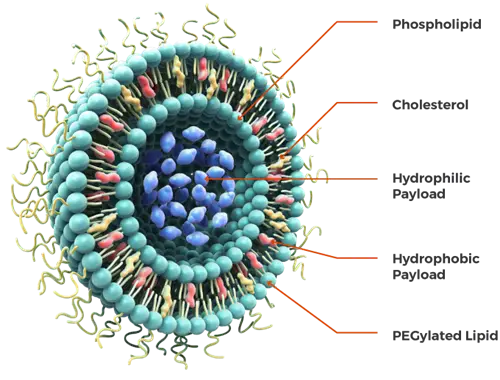This comprehensive review goes deep into the revolutionary application of liposomes within the dietary supplement industry, focusing on their exceptional role in delivering essential nutrients to the body's cells. The article investigates how liposomes (small, spherical, and highly sophisticated vesicles comprising one or more concentric lipid bilayers) have become a cornerstone technology that substantially amplifies the bioavailability of nutrients encapsulated within supplements. By acting as protective carriers, liposomes ensure that nutrients are shielded from the harsh conditions in the gastrointestinal tract, thereby preserving their structural integrity and functional potency until they reach their target sites within the body.
Liposomes are fundamental in directing nutrients efficiently to specific cells or tissues where they are needed most. This targeted approach not only maximizes the therapeutic efficacy of dietary supplements but also minimizes the risk of potential side effects, as it reduces the necessity for high doses while still achieving optimal physiological benefits.(1)

Image: Liposomal structure.
History of liposomes
First discovered in 1961 by British hematologist Alec Bangham, Liposomes have evolved as crucial nutraceutical delivery vehicles. Notable for their biocompatibility and ability to encapsulate both water-loving and fat-loving agents, liposomes facilitate the efficient delivery of nutrients while minimizing risks associated with toxicity.(2)
The development of liposomes has undergone significant refinements since the 1970s. Early versions of liposomes, along with variations like micelles and nanoemulsions, were foundational in creating advanced delivery systems, particularly with the advent of synthetic surfactants and high-shear processing techniques. These innovations reduced particle size, enhancing the resulting products' stability, shelf life and clarity.(3)
Understanding Liposomal Structure
Liposomes are formed from amphiphilic phospholipids. When dispersed in water, these phospholipids self-assemble into bilayers, creating a hydrophobic interior and a hydrophilic exterior. This versatile structure allows liposomes to encapsulate a wide range of nutrients effectively.(4)
In an aqueous environment, phospholipids spontaneously form bilayers with their hydrophilic 'heads' facing the water and hydrophobic 'tails' oriented away. The bilayers then close into vesicles, encapsulating the aqueous solution within.(5)

The beneficial roles of liposomes include the following:(6)
- Enhancing Nutrient Delivery: Liposomes are instrumental in nutrient delivery due to their protective mechanism, increased bioavailability, and potential for targeted delivery.
- Protective Role: The lipid bilayer of liposomes shields encapsulated nutrients from external factors, protecting sensitive compounds from degradation in the digestive tract and increasing their stability.
- Increasing Bioavailability: By facilitating the absorption of encapsulated compounds in the body, liposomes enhance the bioavailability of nutrients, ensuring that a more significant proportion of the active ingredients reaches the systemic circulation.
- Targeted Delivery: Through surface modifications, liposomes can be engineered to target specific cells or tissues, ensuring that the encapsulated nutrients are delivered to the desired location in the body.
Benefits of liposomes in dietary supplements include for example:(7-9)
- Enhanced Absorption: Liposomal supplements demonstrate superior absorption rates compared to traditional supplement formulations, maximizing the effectiveness of the encapsulated nutrients.
- Dosage Efficiency: With increased bioavailability, consumers require lower doses of liposomal supplements to achieve the same or even enhanced therapeutic effects.
- Prolonged Stability: Liposomes extend the shelf-life of supplements by providing a stable environment for the encapsulated nutrients, protecting them from oxidation and degradation.
- Versatility in Encapsulation: From vitamins and minerals to antioxidants and herbal extracts, liposomes can encapsulate various nutrients, making them highly versatile.
- Vitamin Delivery: Liposomes are especially beneficial for delivering vitamins, enhancing the absorption of both water-soluble and fat-soluble vitamins.
- Antioxidant Protection and Delivery: Sensitive antioxidants are often degraded during digestion; liposomes protect these molecules, ensuring they keep the target cells intact.
- Herbal and Botanical Extract Delivery: Many herbal and botanical extracts have low bioavailability when consumed in traditional formats. Liposomal encapsulation significantly enhances the absorption of these beneficial compounds.
Potential disadvantages of liposomal delivery:
- High current cost
- Possibility of poor manufacturing (e.g., high particle size, poor ingredients).
- Possibility of instability
- Increased intracellular delivery
Conclusion
Incorporating liposomal technology within the dietary supplement sector marks a significant stride forward in enhancing nutrient delivery. Through their unique structure and properties, liposomes provide protection, increased bioavailability and precise delivery of encapsulated nutrients. With ongoing research and development, the application of liposomes in dietary supplements is set to broaden, promising more effective and innovative health-promoting products for consumers.
References:
- Keller, B. C. (2001). Liposomes in nutrition. Trends in food science & technology, 12(1), 25-31.
- Shade, C. W. (2016). Liposomes as advanced delivery systems for nutraceuticals. Integrative Medicine: A Clinician's Journal, 15(1), 33–36.
- Koynova, R., & Tenchov, B. (2015). Recent progress in liposome production, relevance to drug delivery and nanomedicine. Recent patents on nanotechnology, 9(2), 86-93.
- Paternostre, M., Ollivon, M., & Bolard, J. (1996). Liposomes: preparation and membrane protein reconstitution. In Manual on membrane lipids (pp. 202-247). Berlin, Heidelberg: Springer Berlin Heidelberg.
- Rudolph, A. S., Ratna, B. R., & Kahn, B. (1991). Self-assembling phospholipid filaments. Nature, 352(6330), 52-55.
- Shade, C. W. (2016). Liposomes as advanced delivery systems for nutraceuticals. Integrative Medicine: A Clinician's Journal, 15(1), 33–36.
- Keller, B. C. (2001). Liposomes in nutrition. Trends in food science & technology, 12(1), 25-31.
- Jahadi, M., Keighobadi, K., Azimzadeh, B., Keivani, H., & Khosravi-Darani, K. (2021). Liposomes as herbal compound carriers: An updated review. Current Nutrition & Food Science, 17(8), 790-797.
- Subramani, T., & Ganapathyswamy, H. (2020). An overview of liposomal nano-encapsulation techniques and its applications in food and nutraceutical. Journal of food science and technology, 57(10), 3545-3555.





